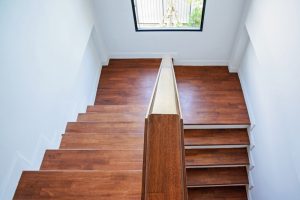
massive wooden staircase raises suspicion
Wood preservatives can be detected in house dust
Before the purchase of older houses, an investigation of the room air on volatile organic compounds brings few insights, if not recently renovation works were carried out. Rather, in the case of old buildings, the analysis of the low-volatile compounds in house dust indicates whether there is a health risk for the inhabitants. Without a concrete suspicion a broadband house dust examination is recommended. The accredited laboratory “Analysis Aurachtal” offers two variants of examination packets: the smaller variant examines fifty compounds, the large study includes 160 compounds. The “fifties” variant contains the most famous contaminated sites, e.g. wood preservatives and other biocides, including pyrethroids, polychlorinated biphenyls (PCP), polycyclic aromatic hydrocarbons (PAH), flame retardants and plasticizers. The most comprehensive analytical series with 160 compounds examines the above-mentioned main groups in more detail, e.g. the biocides listed separately are 1-chloro-naphthalene and 2-chloro-naphthalene. Important supplementary parameters are phenols and isothiazolinones. Another focus is on nicotine in this study series.
The chemist also detects heavy metals in house dust
The analysis of heavy metals requires a higher sample size. Three grams of dust must be delivered at least in the laboratory in order to obtain reliable results. Amongst the tests are arsenic, lead, cadmium, chromium, cobalt, nickel and mercury. Little is known about the fact that heavy metals can also be contained in wood preservatives. Cadmium and lead may be added in stabilizers of polyvinyl chloride. Mercury can be present, for example, as a fungicide in plastics and as an insecticide in paints.
Waiting for laboratory analysis
Back to Benjamin Kramer. In the meantime, the expert has taken the house dust with a standard vacuum cleaner and sent it to the laboratory. The results will be known in just over two weeks. Only then can the buyer be sure whether his dream home is free of wood preservatives and other problematic biocides.
Link
Analytik Aurachtal Information folder
picture source: shutterstock.com
